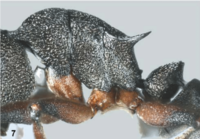Polyrhachis thailandica
| Polyrhachis thailandica | |
|---|---|

| |
| Scientific classification | |
| Kingdom: | Animalia |
| Phylum: | Arthropoda |
| Class: | Insecta |
| Order: | Hymenoptera |
| Family: | Formicidae |
| Subfamily: | Formicinae |
| Tribe: | Camponotini |
| Genus: | Polyrhachis |
| Subgenus: | Myrmhopla |
| Species: | P. thailandica |
| Binomial name | |
| Polyrhachis thailandica Kohout, 2006 | |
The holotype specimen was collected foraging low on a tree trunk in dry evergreen forest at the Thong Pha Phum study site within the Maeklong Watershed Research Station.
Identification
Kohout (2006) - A member of the Polyrhachis cryptoceroides species group. Polyrhachis thailandica is most similar to Polyrhachis jerdonii. Both have a laterally marginate mesosoma and a weakly indicated metanotal groove. They differ in the general sculpturation of the body that, in P. jerdonii, is very finely reticulate-punctate, while it is distinctly more coarsely sculptured in P. thailandica.
Keys including this Species
Distribution
Distribution based on Regional Taxon Lists
Indo-Australian Region: Singapore.
Oriental Region: Thailand (type locality).
Distribution based on AntMaps
Distribution based on AntWeb specimens
Check data from AntWeb
Countries Occupied
| Number of countries occupied by this species based on AntWiki Regional Taxon Lists. In general, fewer countries occupied indicates a narrower range, while more countries indicates a more widespread species. |

|
Estimated Abundance
| Relative abundance based on number of AntMaps records per species (this species within the purple bar). Fewer records (to the left) indicates a less abundant/encountered species while more records (to the right) indicates more abundant/encountered species. |

|
Biology
Castes
Nomenclature
The following information is derived from Barry Bolton's Online Catalogue of the Ants of the World.
- thailandica. Polyrhachis thailandica Kohout, 2006a: 146, figs. 3, 7, 11 (w.) THAILAND.
Unless otherwise noted the text for the remainder of this section is reported from the publication that includes the original description.
Description
Worker
(holotype cited first): TL c. 5.34, 5.54; HL 1.37, 1.37; HW 1.28, 1.28; CI 93, 93; SL 1.34, 1.34; SI 105, 105; PW 1.40, 1.40; MTL 1.56, 1.50 (2 measured).
Mandible with 5 teeth, apical tooth largest with others virtually subequal. Clypeus shallowly, but distinctly concave just behind anterior margin, with strongly raised, median, longitudinal carina; anterior clypeal margin produced into medially incised, laterally rounded flange; basal margin indistinct, obscured by overlying sculpturation. Frontal triangle indistinct. Frontal carinae sinuate with margins distinctly raised medially; central area relatively wide with weakly impressed frontal furrow. Sides of head with distinct longitudinal carina running from occiput towards mandibular bases; in full face view, sides of head in front of eyes strongly converging toward mandibular bases in almost straight line; behind eyes sides narrowly rounding into weakly convex occipital margin. Eyes moderately convex, in full face view not or only marginally reaching lateral cephalic outline. Ocelli lacking. Mesosomal dorsum in profile with pronotum convex anteriorly, mesonotum and propodeum rather flat. Pronotal humeri produced into widely based, anteriorly directed, blunt spines; lateral pronotal margins converging posteriorly; promesonotal suture distinct, flat. Mesonotal dorsum with lateral margins rounded anteriorly, strongly converging posteriorly; metanotal groove weakly indicated. Propodeal dorsum armed with pair of slender, acute, widely diverging spines; inner margins of spines continued medially for some distance but failing to meet, leaving gap through which propodeal dorsum descends into oblique declivity. Petiole with anterior face straight, posterior face convex, almost inflated at base; dorsum armed with pair of curved spines that embrace base of first gastral segment, and pair of short intercalary teeth; teeth joined by distinct, acute ridge, forming, in dorsal view, a clearly defined inverted "v"; ridge continued laterally along dorsal face of spines. Subpetiolar process narrow, bluntly angulate anteriorly and posteriorly, shallowly concave medially. First gastral segment with anterior face concave and anterodorsal margin forming acute ridge.
Mandibles finely reticulate with numerous piliferous pits. Dorsum of head and mesosoma, including pronotal spines, very coarsely reticulate-punctate; sculpturation on petiole distinctly weaker. Propodeal and petiolar spines finely reticulate; gaster shagreened.
Mandibles with short, curved hairs near masticatory borders and numerous decumbent hairs arising from pits towards mandibular bases. Anterior clypeal margin with a few, longer, anteriorly directed setae medially and fringe of short setae towards mandibular bases; a few pairs of medium length, erect hairs arising near anterior and basal clypeal margins; numerous decumbent hairs, partly obscuring underlying sculpturation, covering most of clypeus. A few pairs of short, erect hairs on vertex. Medium length, erect hairs lining apical segments of gaster.
Mandibles dark brown with teeth and inner borders dark red and lighter red band along masticatory borders. Body black, with antennae and legs, including coxae, yellowish or light reddish-brown; tarsi and joints of femora and tibiae a shade darker.
Type Material
Holotype: W. Thailand, Kanchanabur Prov., Maeklong Watershed, 14º 34' N, 98º 50' E, 30.XI.2003, leg. Nawee Noonanant (worker). Paratype: N.E. Thailand, Chaiyapum Prov., Phu Kieo WS, 16.IX. 1998, leg. Decha Wiwatwitaya (worker). Holotype in AMKU; paratype in Queensland Museum.
References
- Khachonpisitsak, S., Yamane, S., Sriwichai, P., Jaitrong, W. 2020. An updated checklist of the ants of Thailand (Hymenoptera, Formicidae). ZooKeys 998, 1–182 (doi:10.3897/zookeys.998.54902).
- Kohout, R.J. 2006a. A review of the Polyrhachis cryptoceroides species-group with description of a new species from Thailand. Myrmecologische Nachrichten. 8: 145-150.
- Wang, W.Y., Soh, E.J.Y., Yong, G.W.J., Wong, M.K.L., Benoit Guénard, Economo, E.P., Yamane, S. 2022. Remarkable diversity in a little red dot: a comprehensive checklist of known ant species in Singapore (Hymenoptera: Formicidae) with notes on ecology and taxonomy. Asian Myrmecology 15: e015006 (doi:10.20362/am.015006).

